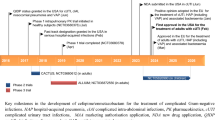Abstract
The activity of cefcanel against anaerobic cocci,Clostridium perfringens, Bacteroides fragilis, Bacteroides spp. and fusobacteria was determined by the agar dilution method and compared with the activity of cefaclor, cephalexin, cefadroxil, phenoxymethylpenicillin and ampicillin. Cefcanel showed good activity againstClostridium perfringens, Bacteroides spp. and fusobacteria (MIC90=1–4 mg/l). Against anaerobic cocci its MIC90 value was 16 mg/l, and againstBacteroides fragilis, 32 mg/l. Cefcanel has an antibacterial activity that warrants investigation in clinical trials.
Similar content being viewed by others
References
Holdeman, L. V., Cato, E. P., Moore, W. E. C.: Anacrobe laboratory manual. Virginia Polytechnic Institute and State University, Blacksburg, VA, 1977.
Dornbusch, K., Nord, C. E., Olsson-Liljequist, B.: Antibiotic susceptibility of anaerobic bacteria with special reference toBacteroides fragilis. Scandinavian Journal of Infectious Diseases 1979, 19: 17–25.
Olsson, B., Dornbusch, K., Nord, C. E.: Susceptibility to beta-lactam antibiotics and production of beta-lactamase inBacteroides fragilis. Medical Microbiology and Immunology 1979, 163: 183–194.
Author information
Authors and Affiliations
Rights and permissions
About this article
Cite this article
Nord, C.E., Lindmark, A. & Persson, I. Comparative antibacterial activity of the new cephalosporin cefcanel against anaerobic bacteria. Eur. J. Clin. Microbiol. Infect. Dis. 8, 550–551 (1989). https://doi.org/10.1007/BF01967478
Issue Date:
DOI: https://doi.org/10.1007/BF01967478




